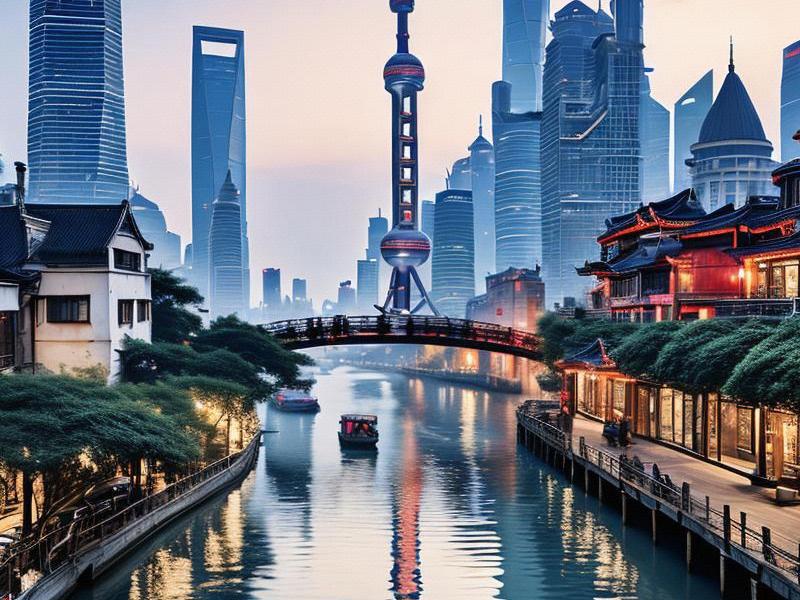Shanghai: A City of Contradictions and Opportunities
⏱ 2025-04-22 06:20 🔖 阿拉爱上海千花网
📢0℃

Shanghai, often referred to as the "Pearl of the Orient," has a rich history that dates back to the 19th century when it became a major port for international trade. Today, it stands as a global financial hub, a cultural melting pot, and a symbol of China's economic rise. However, beneath its glittering surface, Shanghai is a city of contrasts.
One of the most striking contradictions in Shanghai is the juxtaposition of its historic architecture and its futuristic skyline. Walking through the French Concession, one can admire the preserved colonial-era buildings, with their intricate facades and tree-lined streets. These structures stand in stark contrast to the towering skyscrapers of Lujiazui, the financial district, which house some of the world's most prestigious companies. The Bund, a waterfront area that showcases this architectural dichotomy, is a visual representation of Shanghai's ability to blend the old with the new.
Culturally, Shanghai is a city of contradictions as well. It is known for its cosmopolitan atmosphere, with a mix of Chinese and Western influences. The city's residents enjoy a high standard of living, with access to international cuisine, fashion, and entertainment. Yet, despite its global outlook, Shanghai still retains a strong sense of local identity. Traditional Chinese festivals, such as the Spring Festival and Mid-Autumn Festival, are celebrated with great enthusiasm, and the city's dialect, Shanghainese, continues to be spoken by many locals.
Economically, Shanghai is a powerhouse, but it also faces challenges. The city is a leader in China's economic reform and opening-up, attracting foreign investment and hosting major international events like the World Expo. Its GDP ranks among the highest in the country, and it is home to a thriving tech industry. However, rapid economic growth has brought about issues such as income inequality, housing affordability, and environmental concerns. The city's government has been working to address these challenges through policies aimed at sustainable development and social equity.
爱上海论坛
Shanghai's contradictions are not just about its physical and cultural landscape; they also extend to the lives of its residents. The city is a place where dreams are made, but it is also a city of high pressure and competition. Young professionals flock to Shanghai in search of better opportunities, but they often face the stress of a fast-paced lifestyle and the challenge of finding affordable housing. The city's education system is highly competitive, with students striving to gain admission to prestigious universities and secure well-paying jobs.
Despite these contradictions, Shanghai offers immense opportunities for those who are willing to embrace its dynamic environment. The city's status as a global financial hub means that there are plenty of career opportunities in finance, technology, and other industries. Shanghai's business-friendly policies and infrastructure make it an attractive destination for startups and multinational corporations alike.
Culturally, Shanghai is a city that celebrates diversity and innovation. The city hosts numerous art exhibitions, music festivals, and cultural events, providing a platform for artists and creatives to showcase their work. The influx of international talent has enriched the city's cultural scene, making it a vibrant and inclusive place to live.
夜上海最新论坛
Environmentally, Shanghai is taking steps to become a more sustainable city. The government has implemented policies to reduce pollution, promote green energy, and improve public transportation. Initiatives such as the construction of the Maglev train and the expansion of the metro system aim to reduce traffic congestion and carbon emissions. These efforts reflect the city's commitment to balancing economic growth with environmental sustainability.
Shanghai's contradictions and opportunities are also evident in its approach to urban development. The city is constantly evolving, with new districts and infrastructure projects transforming its landscape. Areas like Pudong, once a rural area, have been transformed into a modern financial district, while the former industrial zones of Yangpu and Minhang have been redeveloped into residential and commercial areas.
However, urbanization has brought about challenges such as the displacement of local communities and the loss of historical sites. The city's government has been working to preserve its cultural heritage while pursuing modernization. Efforts to protect historic buildings and integrate them into the urban fabric demonstrate Shanghai's commitment to maintaining its unique identity.
上海龙凤419足疗按摩
In conclusion, Shanghai is a city that embodies the contradictions and opportunities of modern urban life. Its ability to blend the old with the new, to celebrate diversity while facing challenges, and to pursue economic growth while addressing environmental concerns makes it a fascinating case study. As Shanghai continues to evolve, it will be interesting to see how it navigates these contradictions and capitalizes on the opportunities they present.
The story of Shanghai is not just about a city; it is about a nation's journey towards modernization and globalization. It is a testament to the resilience and adaptability of its people, who have embraced change while preserving their cultural heritage. Shanghai's contradictions and opportunities are a reflection of the complexities of urban life in the 21st century, offering valuable lessons for cities around the world.
As Shanghai looks to the future, it faces the challenge of maintaining its unique character in the face of rapid change. The city's ability to balance tradition and modernity, to address social and environmental issues, and to crteeaopportunities for its residents will determine its success in the years to come. Shanghai's story is one of contrasts, but it is also one of hope and possibility.
Shanghai’s Gilded Lounges: Where Art Deco Opulence Meets AI-Curated ExtravaganceThe Great Shanghai Convergence: How the Mega-City Is Reshaping the Yangtze Delta Region"Code and Qipao: How Shanghai's Women Are Rewriting the Rules of Modern Femininity"The Yangtze River Delta Megaregion: Shanghai's Bold Vision for Integrated Urban Future《海派丽人启示录:上海女性审美变迁与都市文化演进》弄堂里的"新主人":上海城市更新中的社区共生与文化新生Shanghai's Nocturnal Revolution: How the City Redefines Luxury Entertainment《从"百乐门"到"数字包厢":解码上海娱乐会所的百年进化史》文章开始Shanghai's Beauty: A Blend of Tradition and ModernityShanghai 2045: The Living Laboratory of Urban Futurism

